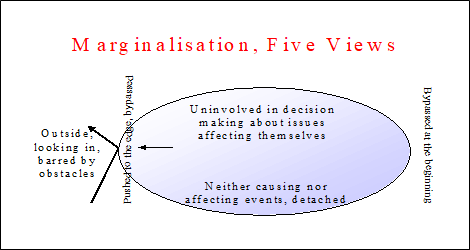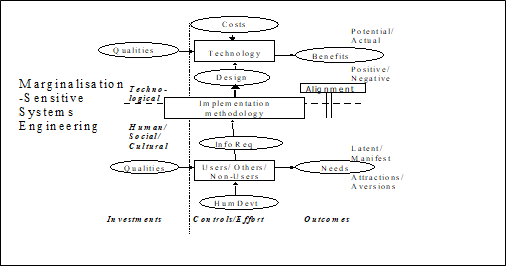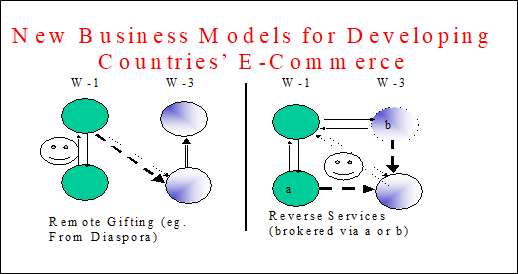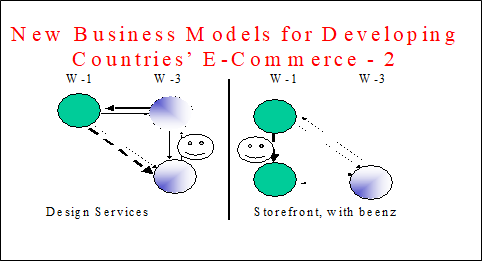Countering E-Commerce Marginalisation through Demand-Centred Measures
The benefits of E-Commerce will hardly be uniform, or even universally positive. For those whom the benefits may accrue in small or negative quantities, we reserve the term “potentially marginalisable” (PM). The huge majority of the PM are in the third world, especially in Africa. Current models of E Commerce make assumptions about business, society, and culture that reinforce the threat of marginalisation at the “edges” of the gloval E-world. This paper explores the implication s of marginalisation and proposes a formal methodology for ensuring that the needs of the PM are taken into account. These are termed “demand-centred measures.”
In a previous paper [1], the authors have pointed out the logical implications of the competitive nature of E-commerce. Far from being a rising tide that raises all boats, E-Commerce is a competitive tool attracting immense investment exactly because of the competitive advantages perceived. While the promise has yet to be achieved, it is clear that the wish-list of benefits is well defined, most neatly explicated by Evans and Wurster [2]. These writers spell out in great detail how to take advantage of the extended reach and richness of the new commercial media without the current limitations defining the relationship between richness and reach .
However, the models underlying E-Commerce as a competitive tool are based on a set of assumptions (termed “supply-side” assumptions in [1]) that imply stratification, or marginalisation of many potential users. Marginalised users (both suppliers as well as buyers) will experience real disadvantages. Avoiding marginalisation (i.e., moving from “potentially marginalised” (PM) to marginalised) is critical to any economic and social analysis of E-Commerce and is a critical element of any third-world national E-Commerce policy. In this paper, we will briefly review this conceptualisation of marginalisation appropriate to E-Commerce. Then we will discuss six ways in which to avoid this marginalisation. These methods are brought together into a formal methodology for E-Commerce development that takes the needs of the PM in third-world economies.
The outline for this paper is as follows:
Consider the technological and commercial bases of E-Commerce. The predicted success of E-commerce depends on communication advances and intermediation effects. There are three types of intermediation that are imoprtant. First, there is the intermediation possible through electronic means such as WAP, the Internet, and similar protocols. Next, there is the disintermediation of existing face-to-face or telephonic (or more primitive) relationships. Finally there is reintermediation through navigators and others who take advantage of the richness of these media and make richness more “available” [2]. This is how it’s supposed to work. Note that each of these concepts takes into account two players, one on the supply side (the vendor, supplier, or business operator) and one one the demand side (the purchaser, buyer or user). To be sure, consumer-to-consumer E-commerce (such as auctions, for example) don’t have such noticeable “suppliers”, but it doesn’t take a deep analysis to understand that the service offered (as opposed to the goods or actions or outcomes) is supplied by someone who is not a user or receiver of service.
Now, let’s turn our attention to the creation or offering or development of an E-commerce venture and explore the distinction between these two concepts of supply-side development and demand-side development.
First, development means advancement of an idea, community, or technology and it comes from a direction. The supply side direction is from those who are creating the idea or technology or directing a community. The demand side is, correspondingly, from those are using the idea or technology or who live or act in the community.
Second, development is not passive, but active. Suppliers “push” their offerings onto the users or customers or residents, who have a “pull” for services or products. In the tension between these two forces, there is a transaction. Until recently “push” technologies have had the upper hand. Business-to-consumer (B-C) and Government-to-Consumer efforts are most likely to be push situations, whereas business-to-business efforts may be of both types.
Current wisdom is that E-Commerce is a supply-side enterprise. Suppliers will push their offerings onto a consuming public who will increase through a network effect (note how Amazon.com works with the portal Yahoo.com to take advantage of network effects) to further enlarge the customer base.
Sgtrictly stated, a supply-side venture will hyopthesise customer needs and satisfaction, both of which must be established over some period of time. They are generally blind to specific geographic community or upliftment goals. The measures of success of such ventures are based on models of commerce in which selling is the sole desiderata of commerce. Hence, measures of success will make false assumptions about the nature of the activity of commerce itself. Commerce can in fact, serve many other purposes (such as community building, communication, training, social stratification, development of national or regional symbols, age-grading, and other social, political, and cultural roles) and thus so can E-commerce.
Hence traditional measures of success are not necessarily appropriate in developing countries, with respect to developing technologies or developing business modes. For example, merely having the technology available, without economic success, might be an important, desired outcome. Developing human potential or resources might be a measure of success that is somewhat independent of business outcomes.
However, by traditional measures most B-C offerings are failures. These traditional measures look at cash flow and profits and few first-world companies are making money. Most trials “fail” in the third world, but we learn little about this kind of failure, because of a number of factors, largely having to do with the fact that the trials aren’t built for research.
Few trials build in testable implications such as technology transfer, continuing costs, cultural disturbance, non-economic fall-out, and other dependent variables. Of course it is silly to think of free-enterprise ventures as “experiments” we can learn from. But the fact is that learning is proceeding even more atheoretically than most IT situations. It seems like we are always running behind the technology trying to understand what it is doing.
Compounding that problem is that most E-Commerce trials ignore the disadvantaged. This is also unsurprising since
1. They don’t have a lot of money to spend on E-commerce as either suppliers or users
2. They have disadvantages that make it difficult for them to access E-commerce (necessary condition), use E-commerce (necessary condition) or profit from its use.
3. There are serious opportunity costs for the disadvantaged, such as time better spent finding employment, housing, water, etc. It is unlikely that we could design rigorous research of a “trial” nature that includes the disadvantaged in an essential way. That shouldn’t stop us trying.
One of the problems with designing research around marginalisation is an assumption that E-commerce is a win-win game; in fact, it is competitive. Even when the competitors are main stream, the (corporate) losers generally “download” their losses to employees, customers, suppliers.
They do this in a number of ways. First, they try out various E-commerce modes, means, and media. E-commerce is new and most trials are less than two years old. Little is known about power relationships although many writers, such as Evans and Wurster, speculate about a change due to richness and reach. But the most important thing is that when E-commerce is designed to mimic or extend existing ways of doing commerce, demand is ignored through supplier-driven trials. If demand is ignored, then demand-based losers cannot be “empowered” in any sense other than receiving “value for money.”
Speculation that consumers can gain power by controlling their own information [3] is just that. The idea that business originates with suppliers automatically places the burden of following the game on consumers. The disadvantaged fall squarely in this group for now. In other words, the failure of trials has true costs to players.
Even where the disadvantaged are on the supply side, there are real problems with learning and survival. These costs, in turn, may be passed on to consumers or customers. Among these customers, the disadvantaged have the most to lose (their time, for instance) with little promise of gain. Stated another way, when a microbusiness fails, not only do its suppliers fail along with it, but its customers fail through switching costs and real costs of playing. There are true exit barriers to E-Commerce. These costs are almost as important as the barriers to entry for potentially marginalisable groups who want to get into E-Commerce “on the ground floor.” This is likely where they will stay, or to reuse the nautical metaphor, at the bottom of the economic sea.
For those countries not yet on the E-Commerce bandwagon, the complexity of development of an E-conomy makes it unlikely that leapfrogging strategies will work generally. Each of the states that has leapfrogged has had a special resource or capability not duplicable elsewhere. There are few such examples (Singapore, South Korea, and Ireland, for example) and each is special.
There are five distinct views of marginalisation (Figure 1) as follows.

Figure 1: Marginalisation: Five Views
Marginalisation-1: Out of the Domain of Discourse
One important view of marginalisation is that of being left out of the definition of the domain of discourse. This creates additional barriers to entry for both marginalised suppliers and vendors. Their problem is how to avoid the initial lack of resources (I.e., the initial barrier to entry) or influence or design or standard-setting. It is clear that E-commerce and related E-business standards are set by and modelled on the way business is conducted in the first world. While it may be argued that these principles are universal, there are obvious and pressing reasons why these standards should be flexible.
Marginalisation-2: Technical and Economic Barriers to Entry via the Technology Life Cycle
While the cost of entry of a consumer to E-Commerce may plummet (depending, of course, on factors such as literacy, access, and familiarity), the cost of entry for a marginalised supplier rises as sophistication takes over through the natural inflation of complexity that is caused by intelligent and almost perfect competition. The marginalised are almost by definition small, unsophisticated, lacking complex business relationships and history (at least globally, although local knowledge is likely to be very high indeed). Especially in E-commerce, where competitive gambits are by definition open to everyone, it is expected that every single advance in technology will be quickly swept into implementations, giving rise to ever-increasingly sophisticated websites, interoperability, interconnection, etc. For instance, the “standard” interface, increasingly technologically complex, will become an unacceptable subminimum from a competitive point of view for the marginalised, both as consumers, and more devastatingly, as suppliers. This removal of the supplier from a local economy has elsewhere been referred to as the “hollowing out” of an economy [5].
Marginalisation-3: Left out of the Value Chain
By being neither the cause nor the effect of E-Commerce events (ECE) and being left out of the “value chain”, the marginalised lose contact with what is happening and become irrelevant to decision makers, field testers, trials, and so forth. This sort of marginalisation creates the sort of non-person situation in which decision makers do fail to see the marginalised even when faced with them. This can result, as it has in other areas, in trials that are aimed at only those who can make themselves heard, generally elites.
Marginalisation-4 : Pushed to the Periphery
A more active form of marginalisation stems from the nature of competition. It is natural for businesses, industries, governments, and others to ignore those it can’t interact with for a variety of reasons. Where the ignorance becomes systematic and discriminatory, of course, the government in a liberal society moves in to guarantee access through law or entitlements. However, where technology is concerned, governments move far too slowly and, in any event, it’s almost impossible to foresee all the ways emergent or even not-yet-emergent technologies will discriminate. For the existing technology of E-commerce, this discrimination works strongly through language and literacy, business sophistication, transportation barriers, financial-institutional drawbacks (such as lack of credit cards), and cultural barriers.
Marginalisation-5: Not Being Considered or Represented
The truly marginalised never have representation, since their interests are either too small or too unimportant to recognise. In this sense, decisions about E-Commerce are being made without consideration of those who are marginalised, even if the marginalised aren’t literally forced to the margins, forced through the margins or barred from the inside.
The Cast of Those Marginalised
The ranks of the marginalisable are legion, of course. Of interest to our project are these communities, some of which are easy to find, others of which lack spatial, vocational or cultural definition. These include small farmers, informal traders, the unemployed, the un(der)educated, the poor, the already marginalised, non-English speakers, and the disabled.
Each of these groups is characterized in some way (although none actually form a society in the traditional sense and none except perhaps the poor and the disabled have coordinating bodies and then generally only in the developed world) and each experiences one or more of the forms of marginalisation mentioned previously. Determining the kinds, the degrees, sources, and persistence of the marginalisation is outstanding research.
Marginalisation in E Commerce Compared
|
||||
Type |
Definition |
Cause(s) |
Barriers |
Effects, eg. |
Domain of Discourse |
Left out of defi-nition or consi-deration |
Definitions leave out the PM |
Defined out of existence |
Setting of impossible standards |
Technical Barriers to Entry
|
Haven’t got resources to enter |
Technology life cycle induces a kind of inflation of effort and resources |
Resource, business culture |
Never accumulate the capital to enter |
Value Chain
|
Left out of information flow, views or situation are not known to others |
Lack of natural or acquired niche in the value chain |
Irrelevance, ignorance |
Creation of Elites who can provide or procure infor-mation |
Peripher-alisation
|
Elbowed aside through natural competitiveness of others |
Lack of skills, influence, education, connections |
Language, literacy, other social barriers |
Never can compete, can’t accumulate resources |
Represen-tation
|
Haven’t got appropriate or useful representatives |
Interests are too small or not understood by others; can’t represent selves |
Size, lack of voice |
No influence in decision making or efforts, trials or campaigns; always begging |
Table 1. Comparison of the Five Kinds of Marginalisation
Based on the above analysis, there seem to be six ways to avoid marginalisation, none of which has a definitive methodology.
1. Avoiding prior marginalisation [7]
2. Bridging the resource barriers
3. Resisting competitive pressure to push to the margins
4. Building an E-Commerce “safety net”
5. Empowering decision making through demand-side dialogue
6. Understanding hidden assumptions of a cultural, social, economic and political nature
The first sounds like an absurdity, but of course in developing nations where the E-Commerce infrastructure is yet to be constructed, it is possible to think about a legal framework to avoid one or more forms of marginalisation at the start. Resource barrier work is under the perennial banner of “Access” or “Training”. Resisting the pressure to push others to the margin requires active intervention through advocacy groups, Chambers of Commerce, NGOs, CBOs, and GROs. An E-Commerce safety net is a vague concept that requires a lot of conceptual and economic work. A supply-side dialogue could work through the auspices of organisations such as the ADF, national NGO organisations, and national welfare and commerce departments. We prefer, as researchers, to examine hidden assumptions in E-Commerce that lead to marginalisation. It is the purpose of this paper to lay out the issues; deriving detailed strategies with regard to marginalisation is a long-term goal of our research program.
Designing a Demand-Side Initiative
A common aspect of avoiding marginalisation strategies is to get taken into account. We feel that one of the major reasons why the PM are so vulnerable is that marketers and system developers, who must cooperate closely to build E-Commerce offerings, fail to heed information about the PM because their methods are unlikely to take the PM into account. “Out of sight” is indeed “out of mind.” Hence, one aspect of our research and development program is to create a methodology for supply-side initiatives that take customers into account. We plan to adopt this general method as a means for moving towards a demand-side methodology.

Figure 2: Demand-Side Development Methodology
1. Model the customer
2. Consider laws, customs, social norms, business styles when developing E-commerce offerings and include the marginalised in any development methodology
.
3. Work through demand-side suppliers such as chambers of commerce, business and development coops, communities, consumer groups, NGOs, CBOs, GROs, community planners to build appropriate business models.
4. Consider vulnerability as a user characteristic in design rather than consider it an optional extra.
5. Design for equitable outcomes. These don’t disadvantage and marginalise users of any sort. On the other hand this is a difficult thing to do without destroying the competitive nature of commerce, since everyone, suppliers and customers in effect compete.
6. Adopt a demand-side specific design methodology, depicted in figure 2. Of course, the devil is in the details, to be filled in later! We know that the following, however, will be important:
a. Assessing the competitive position of vulnerable groups, including defining what competition is for these groups.
b. Focusing on case studies and narratives (i.e., qualitative data) rather than counting. Most of the bases for E-Commerce offerings use a small number of models that cannot be evaluated independently of vulnerability.
c. Focusing on human development rather than technological capability
One additional thing to look at is a variety of business models that involve the potentially marginalisable because they violate and compensate for hidden assumptions in the standard business models.

Figure 3: New Business Models
Remote Gifting (Figure 3) allows members of the African Diaspora through Ethiogift [8] to order items in America to be delivered in Ethiopia as gifts to “the folks back home.” This overcomes the problem of moving money via credit card in Ethiopia, where such facilities are rare indeed and the need to move goods long distances into or out of a third world country.
While we normally think of the third world as requiring the services of the first world, in fact reverse services are highly marketable. In Senegal, school children are tutoring their counterparts in Quebec in French. Senegalese French is high quality international (industrial strength!) quality. Jacques Rostenne [9] has designed and is helping market this service via a 1-800 number in Quebec. A similar example is an internet-based call centre operating from Uganda to service North American users of electronic equipment.

Figure 4: New Business Models II
Similar to reverse services are design services (Figure 4) such as software design (common enough in India) where clients in North America are provided with designs (interior, architectural, or, more commonly, cloth and handicraft) through the web. It is not unthinkable that website design services could be offered this way. A software product moves much more easily than a hard product.
Finally, the beenz revolution [10] not only circumvents the financial barriers that a lack of credit brings, but counteracts several forms of marginalisation through guerrilla consumerism. Many of the sites that pay beenz for viewing banners weren’t meant for people who don’t understand them and can’t actually purchase the products. However, in a more genteel way, it is possible for third-world users to earn beenz by viewing and critiquing various storefronts and participating in marketing trials not of the product but the store itself.
In these ways, we can explore hidden assumptions and derive valuable alternative E-Commerce models.
[1] Wurster, Philip, and Thomas Evans. Blown to Bits. Cambridge, MA: Harvard University Press, 1999.
[2] Miller, Tanya. Disintermediation and Reintermediation in the Unit Trust Industry. Unpublished Master’s Dissertation, University of Cape Town Department of Information Systems, 2000.
[3] Hagel, John and Jeffrey Rayport. “The Coming Battle for Customer Information.” Harvard Business Review Jan-Feb 1997, pp. 53-65.
[4] Neufeldt, Victoria. Webster’s New World Dictionary. New York: Webster’s New World Dictionary, 1991, pg. 827.
[5] Lowe, Vincent. E-Commerce Discussant at Global Knowledge II Conference, Kuala Lumpur, March 12, 2000.
[6] Licker, Paul. Management Information Systems: A Strategic Leadership Approach. Ft. Worth: Dryden Press, 1997, pp. 175-177
[7] Licker, Paul and Nigel Motts. “Extending the Benefits of E-Commerce in Africa: Exploratory Phase.” Proceedings, First Global Information Technology Management World Conference, Memphis TN, June 2000, pp. 115-118.
[8] Ethiogift website: http://www.ethiolink.com/EthioGift/, accessed 4 July 2000.
[9] Rostenne, Jacques. “E-Business in Africa, Challenge and Promise.” Discussion Paper prepared for IDRC SMEITT meeting, April 2000.
[10] Beenz website: http://www.beenz.com/splash.html, accessed 4 July 2000.
In a series of articles for the Harvard Business Review, later published as a single volume, Evans and Wurster define richness as the amount or volume of information available per unit of access and reach as the volume of people who can actually access the information. For traditional media, such as newspapers and television, they postulate a fixed, perhaps linear, relationship. The web, because of its user-driven characteristics and near ubiquity (at least in the developed world), “breaks” these fixed relationships. Almost any amount and type of richness is available (text, sound, image, video, interaction) to almost the entire web at any time, depending on who is willing to put the effort into retrieving the information. Their hypothesis is relatively simple-minded and exaggerated in its implications, but they are the first to study this potential tradeoff in detail in a competitive situation. A great deal could be made of the fact that a supplier’s richness isn’t exactly the same as a buyer’s richness simply because it requires a great deal of skill to create or to use richness; these skills are not uniformly distributed in any society and are far more highly skewed in third-world society. Elites have the resources ability to access media richness; just consider how long it takes to download graphics compared to text, for instance.
Of course on one level the richness is always “available.” But such richness in the hands of sophisticated suppliers generally brings on complexity in terms of number of sources, relationships of sources, structure of purchase/delivery/installation/service arrangements, and so forth. Interpreting this complexity is the job of navigators. Opportunities abound for new services that, in a perverse technological turn, become not merely nice-to-have but essential to make sense of an increasingly sophisticated web of offerings. In other words, demand-side richness is a two-edged sword, given inherent limitations in buyers’ skills. “Available” isn’t enough to mean “useful.”
The Potentially Marginalisable.
Source: http://www.sba.oakland.edu/faculty/licker/personal/research/output/presentations/marginal.doc
Web site to visit: http://www.sba.oakland.edu
Author of the text: indicated on the source document of the above text Prof. Paul Licker
If you are the author of the text above and you not agree to share your knowledge for teaching, research, scholarship (for fair use as indicated in the United States copyrigh low) please send us an e-mail and we will remove your text quickly. Fair use is a limitation and exception to the exclusive right granted by copyright law to the author of a creative work. In United States copyright law, fair use is a doctrine that permits limited use of copyrighted material without acquiring permission from the rights holders. Examples of fair use include commentary, search engines, criticism, news reporting, research, teaching, library archiving and scholarship. It provides for the legal, unlicensed citation or incorporation of copyrighted material in another author's work under a four-factor balancing test. (source: http://en.wikipedia.org/wiki/Fair_use)
The information of medicine and health contained in the site are of a general nature and purpose which is purely informative and for this reason may not replace in any case, the council of a doctor or a qualified entity legally to the profession.
The texts are the property of their respective authors and we thank them for giving us the opportunity to share for free to students, teachers and users of the Web their texts will used only for illustrative educational and scientific purposes only.
All the information in our site are given for nonprofit educational purposes